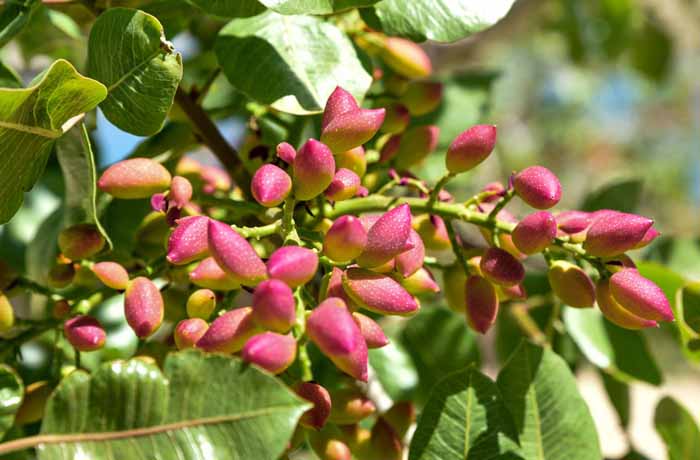La Pistachia vera e’ una pianta non ermafrodita di origine persiana, dal fusto corto non dissimile nel suo aspetto al fico. Il maschio il cui polline feconda la “Pistachia vera” e’ il terebinto (Pistacia Terebinthus), localmente chiamato “scornabecco” o anche “spaccasassi”. Dal seme nasce prima il terebinto che viene successivamente innestato. Le foglie sono composte, formate da 3-5 foglioline di forma circolare ellittica, di colore verde scuro. La specie e’ dioica: si hanno infatti piante maschili e piante femminili.
La riproduzione avviene da seme, a germinazione primaverile, e la messa a dimora in pieno campo,
quando la pianta ha raggiunto l’eta’ di circa cinque o sei anni. Il frutto si presenta in grappoli simili a quelli delle ciliegie, ma con molto maggiore numero di frutti. Sono delle noci, con mallo gommoso e resinoso dal colore bianco-rossastro al momento della maturazione, che avvolge il guscio legnoso molto resistente.
Sara’ per lo straordinario connubio tra la pianta e il terreno lavico, ricco di sali minerali, sara’ per il sole e l’aria di questa terra; sta di fatto che il frutto prodotto in questo lembo dell’isola cresce rigoglioso e supera dal punto di vista dell’aroma, del gusto e delle proprieta’ organolettiche la restante produzione mondiale. Nessun altro ha un colore verde smeraldo cosi’ brillante e un profumo cosi’ intenso, resinoso e grasso.
THE FRUIT Pistachia vera is a non-hermaphrodite plant of Persian origin, with a short stem not unlike the fig tree in its appearance. The male whose pollen fertilizes the "Pistachia vera" is the terebinth (Pistacia Terebinthus), locally called "scornabecco" or also "stone breaker". The terebinth is born first from the seed and is subsequently grafted. The leaves are composed, formed by 3-5 leaflets of an elliptical circular shape, of a dark green color. The species is dioecious: in fact, there are male and female plants. Reproduction occurs from seed, with spring germination, and planting in the open field, when the plant has reached the age of about five or six years. The fruit comes in clusters similar to those of cherries, but with much greater number of fruits. They are walnuts, with a rubbery and resinous husk with a reddish-white color at the moment of ripening, which wraps the very resistant woody shell. It will be for the extraordinary combination of the plant and the lava soil, rich in mineral salts, it will be for the sun and the air of this land; the fact is that the fruit produced in this strip of the island grows luxuriantly and outstrips the remaining world production from the point of view of aroma, taste and organoleptic properties. No one else has such a bright emerald green color and such an intense, resinous and fatty scent.
